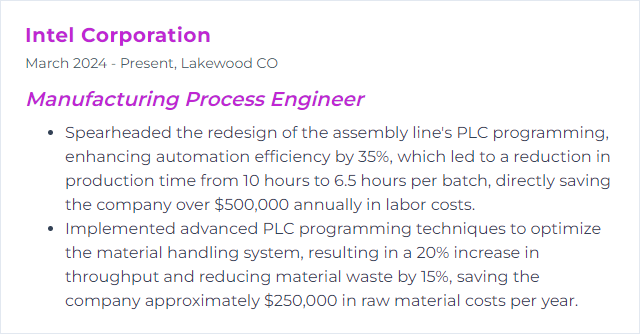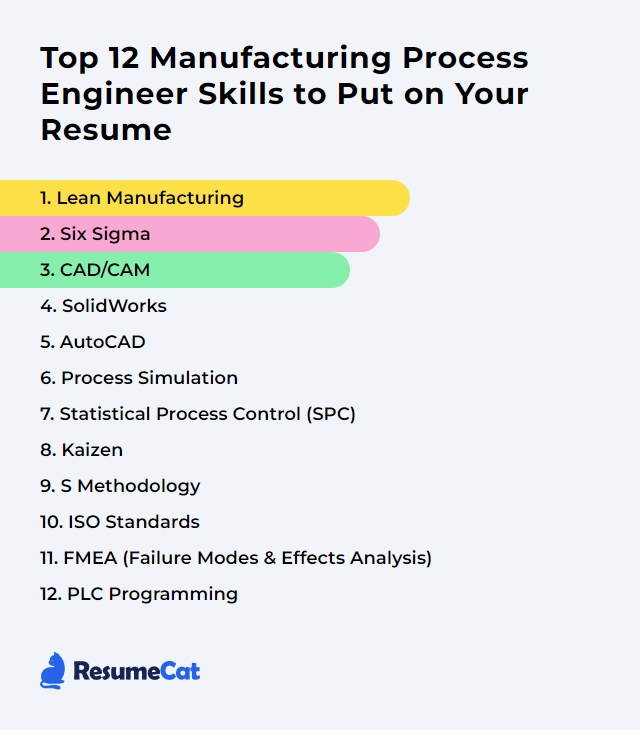Top 12 Manufacturing Process Engineer Skills to Put on Your Resume
In today's competitive job market, standing out as a manufacturing process engineer means showing a sharp mix of technical depth and people skills on your resume. Put the capabilities that prove you can streamline processes, crush waste, and lift throughput right up front. That’s how you catch hiring managers and move your career forward.
Manufacturing Process Engineer Skills
- Lean Manufacturing
- Six Sigma
- CAD/CAM
- SolidWorks
- AutoCAD
- Process Simulation
- Statistical Process Control (SPC)
- Kaizen
- 5S Methodology
- ISO Standards
- FMEA (Failure Modes and Effects Analysis)
- PLC Programming
1. Lean Manufacturing
Lean Manufacturing is a disciplined way of driving out waste while boosting flow and value. It tightens cycle times, raises quality, and builds a culture of continuous improvement with respect for people at its core.
Why It's Important
Lean shortens lead times, trims costs, and stabilizes quality. For a Manufacturing Process Engineer, that translates into smoother lines, fewer defects, and a production system that flexes quickly to demand.
How to Improve Lean Manufacturing Skills
Make lean real with practical moves that stick:
Value Stream Mapping: Map every step from supplier to customer to expose delays, rework, and bottlenecks.
5S: Sort, Set in order, Shine, Standardize, Sustain. Organized workplace, fewer accidents, faster finds.
Kaizen: Small, steady improvements driven by the people who do the work. Make it daily, not annual.
JIT and Pull: Build only what’s needed, when it’s needed, in the quantity needed. Cut inventory and hidden waste.
Root Cause Analysis: Use 5 Whys and fishbone diagrams to fix the cause, not the symptom.
Standard Work: Lock in the best-known method. Train to it. Improve it again.
Digital and Automation: Automate repetitive tasks and instrument processes for data you can act on.
Focus here and you’ll feel lead times compress and first-pass yield climb.
How to Display Lean Manufacturing Skills on Your Resume
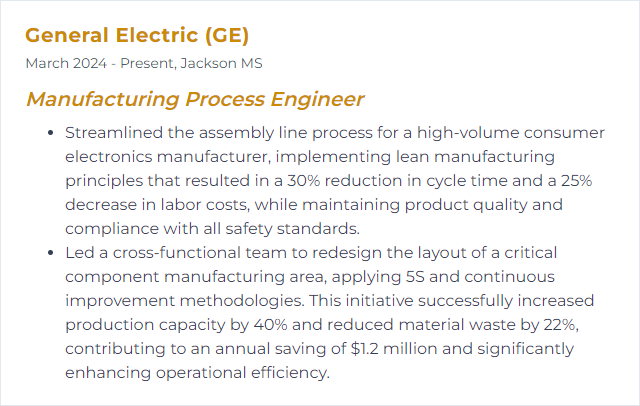
2. Six Sigma
Six Sigma is a data-driven method to reduce variation and defects. It hunts down root causes and bakes control into the process.
Why It's Important
For manufacturing engineers, Six Sigma boosts capability, steadies quality, and trims cost by removing the noise that drives rework and scrap.
How to Improve Six Sigma Skills
Lift your impact by tightening the discipline:
Know the Process: Build clear process maps and value streams. See flow, see waste, see interactions.
Run DMAIC with Rigor: Define, Measure, Analyze, Improve, Control. No skipped steps, no fuzzy measures.
Use Statistics that Matter: Control charts, capability analysis, hypothesis tests, DOE. Let data decide.
Enable the Team: Train cross-functional partners. Solve as a unit; sustain as a unit.
Modern Tooling: Use analytics and quality software to speed data collection, visualization, and analysis.
Benchmark and Learn: Compare against leaders. Set targets that stretch but don’t snap.
Commit to the method and the numbers will tell the story—defects down, sigma up.
How to Display Six Sigma Skills on Your Resume

3. CAD/CAM
CAD/CAM blends computer-aided design with computer-aided manufacturing. Design precise models, generate toolpaths, and connect directly to the machines that make the parts.
Why It's Important
It shortens design-to-make time, reduces translation errors, and lets you iterate fast. Fewer surprises on the shop floor and a quicker march to production.
How to Improve CAD/CAM Skills
Turn the dials that matter:
Invest in Training: Stay current on your platform of choice (e.g., Fusion 360, Mastercam, NX, SolidWorks CAM).
Tight CAD–CAM Integration: Keep a clean digital thread so changes propagate without manual rework.
Automate the Routine: Templates, feature-based machining, and rules reduce clicks and mistakes.
Optimize Toolpaths: High-efficiency roughing, rest machining, verified feeds/speeds, and simulation to avoid crashes.
Script and Customize: Use APIs or macros to tailor workflows to your shop’s quirks.
Manage Data: PLM/PDM for revisions, approvals, and collaboration across teams.
Right Hardware: Workstation-class CPU/GPU, plenty of RAM, SSDs, and tuned drivers for smooth simulation and rendering.
Do this well and you’ll see setup times drop and spindle time climb.
How to Display CAD/CAM Skills on Your Resume
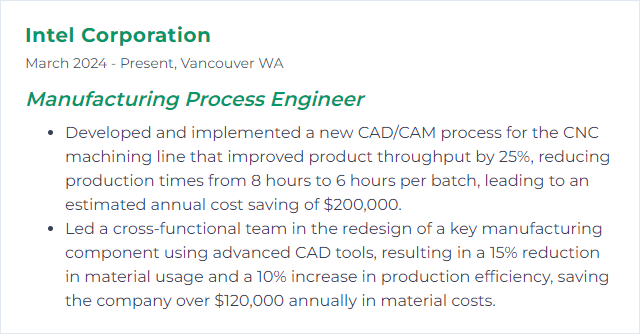
4. SolidWorks
SolidWorks is a 3D CAD platform for modeling parts, assemblies, and manufacturing documentation, with simulation and CAM options standing by.
Why It's Important
It enables fast design iterations, interference checks, and early validation so issues surface on-screen instead of on the line.
How to Improve SolidWorks Skills
Sharpen both speed and depth:
Master the Core: Sketching discipline, feature order, mates, configurations—get the fundamentals crisp.
Use Simulation: Run structural and motion checks to validate before metal meets machine.
Customize: Shortcuts, macros, templates, and the API to trim friction from daily work.
Bridge to CAM: SolidWorks CAM or integrated CAM flows to close the loop from design to NC code.
Stay Current: Adopt new releases. Follow user groups. 3DEXPERIENCE World is where the roadmap and tricks spill out.
Practice on Real Problems: Side projects, shop challenges, reverse engineering—build muscle memory.
Community and Learning: Tap into forums and courses (e.g., LinkedIn Learning) for targeted skill gaps.
The goal: clean models, minimal rebuild errors, drawings that production trusts.
How to Display SolidWorks Skills on Your Resume
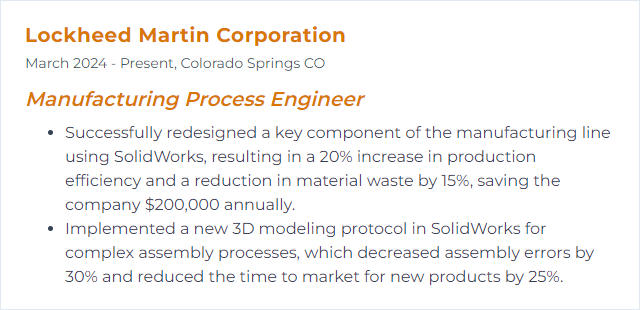
5. AutoCAD
AutoCAD delivers precise 2D/3D drafting—layouts, utilities, jigs, and factory plans—vital for process engineering and equipment placement.
Why It's Important
Accurate drawings prevent layout clashes, streamline installs, and keep specs tight across teams and vendors.
How to Improve AutoCAD Skills
Make drafting faster and sturdier:
Formal Training: Take structured courses from Autodesk and modern platforms like LinkedIn Learning.
Customization and Automation: LISP, scripts, tool palettes, and custom blocks crush repetitive tasks.
Specialized Toolsets: Use discipline toolsets for manufacturing and mechanical detail when available.
Standards: Apply company CAD standards and relevant industry norms (e.g., ASME Y14.5 for GD&T).
Collaborate: Use reference files, sheet sets, and markups to coordinate changes quickly.
Continuous Review: Collect feedback from maintenance, fabrication, and operations; refine templates accordingly.
Speed plus consistency—drawings that are easy to read and even easier to build from.
How to Display AutoCAD Skills on Your Resume
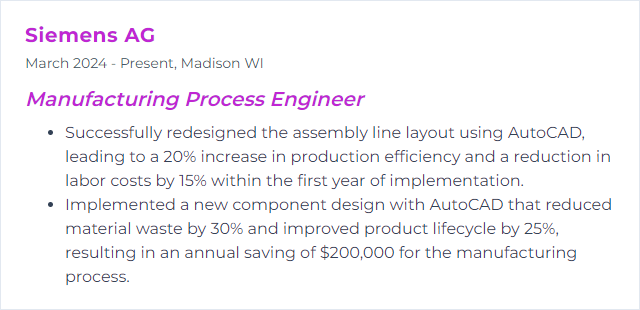
6. Process Simulation
Process simulation uses digital models to mirror your line, test scenarios, and find the best path without touching production. Think throughput, WIP, cycle time—before you spend a dime on changes.
Why It's Important
It de-risks decisions. You can evaluate buffers, staffing, machine choices, and layouts while the plant keeps running.
How to Improve Process Simulation Skills
Build models that decision-makers trust:
Know the Process: Inputs, outputs, constraints, failure modes—document reality first.
Pick Fit-for-Purpose Tools: Platforms like Tecnomatix Plant Simulation, AnyLogic, Arena, or FlexSim depending on scope.
Data Quality: Time studies, changeover timing, scrap rates, MTBF/MTTR—measure what matters.
Calibrate: Tune the model until it mirrors current-state performance within reasonable error.
Verify and Validate: Peer reviews, historical comparisons, and pilot tests build credibility.
Optimize: Run what-ifs for bottlenecks, buffers, batch sizes, scheduling, and layout tweaks.
Keep It Live: Update models as processes change; use them as ongoing planning tools.
The payoff shows up in fewer blind alleys and better capital decisions.
How to Display Process Simulation Skills on Your Resume

7. Statistical Process Control (SPC)
SPC applies statistics to monitor processes, separate common cause from special cause variation, and act before defects spread.
Why It's Important
Real-time insight prevents drift, reduces scrap, and stabilizes output. It’s quality at the source, not inspection at the end.
How to Improve Statistical Process Control (SPC) Skills
Give SPC real teeth:
Training: Teach teams the why and how—control charts, capability indices, and reaction plans.
Real-Time Data: Instrument critical points. SCADA/MES feeds charts without manual lag.
Right Tools: Use X̄-R, X̄-s, p/np, c/u charts, Pareto, and capability studies matched to your data type.
Review and Adjust: Recalculate limits when processes improve. Remove special causes before locking limits.
Continuous Improvement Culture: Tie SPC signals to structured problem-solving and standard work updates.
Quality Software: Deploy platforms that visualize trends, trigger alerts, and simplify analysis.
Integrate with QMS: Connect SPC to ISO 9001 processes—nonconformance, corrective action, and audit trails.
When people trust the charts, they act fast—and defects don’t get a second chance.
How to Display Statistical Process Control (SPC) Skills on Your Resume
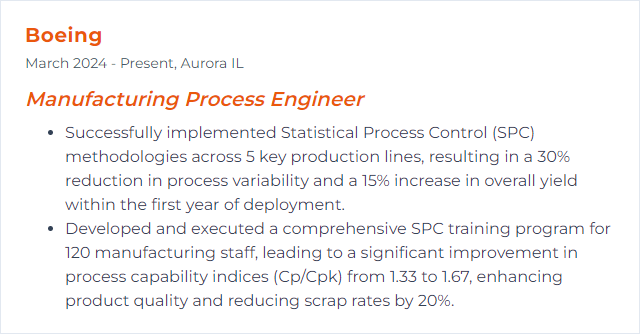
8. Kaizen
Kaizen means relentless, incremental improvement—every person, every day, everywhere in the operation.
Why It's Important
It compounds. Tiny fixes stack into big gains: safer workspaces, faster flow, tighter quality, lower cost.
How to Improve Kaizen Skills
Make improvement habitual:
Continuous Learning: Share short lessons on problem-solving, waste types, and standard work. Bite-sized, frequent, practical.
Involve Everyone: Idea boards, quick experiments, and open feedback loops. Frontline voices lead the way.
Standardize: Document the new best way after each improvement. Visual SOPs help it stick.
Root Cause First: Use simple, consistent tools (5 Whys, fishbone) to prevent recurrence.
Leverage Technology: Use lightweight dashboards and automation where they unblock flow and expose waste.
Visual Management: Cells, kanban, status boards—status at a glance prompts immediate action.
Cadence: Short, regular reviews to celebrate wins, remove barriers, and pick the next target.
When Kaizen becomes routine, momentum does the heavy lifting.
How to Display Kaizen Skills on Your Resume
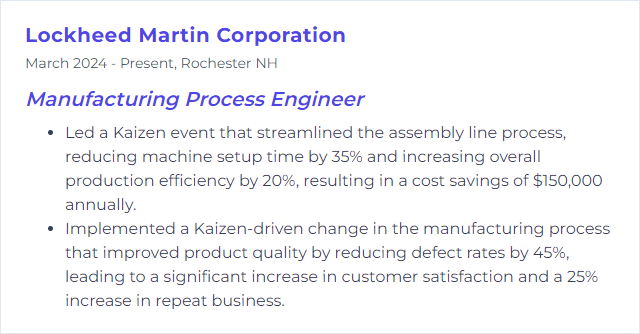
9. 5S Methodology
5S is a workplace organization system: Sort, Set in order, Shine, Standardize, Sustain. It clears clutter, makes problems visible, and speeds work.
Why It's Important
For process engineers, 5S is the on-ramp to stability. Safer spaces, fewer searches, fewer defects, and setup times that stop dragging.
How to Improve 5S Methodology Skills
Keep it practical and visible:
Streamline Systems: Start with 5S audits. Fix the top offenders that slow operators down.
Sustainability: Mark locations, label standards, and schedule light-weight checks. Make the right way the easy way.
Scale with Quality: Pair 5S with Lean/Six Sigma so improvements hold as you grow.
When 5S fades, chaos creeps back. Guard the gains.
How to Display 5S Methodology Skills on Your Resume
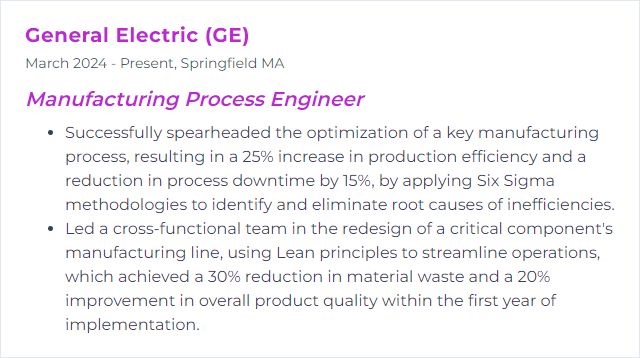
10. ISO Standards
ISO standards set shared rules for quality, safety, and efficiency. In manufacturing, they anchor consistent processes and documentation that customers and regulators can trust.
Why It's Important
They enable repeatability, smoother audits, reliable suppliers, and easier global trade.
How to Improve ISO Standards Skills
Run ISO like a living system, not a binder:
Gap Analysis: Compare current practice to requirements; prioritize high-risk gaps.
Training: Keep teams current on roles, procedures, and change control.
Process Optimization: Use Lean to simplify flows and remove non-value tasks within the QMS.
Document Control: Robust versioning, approvals, and access. No shadow SOPs.
Internal Audits: Risk-based schedules, actionable findings, and follow-through.
CAPA: Clear ownership, root cause, and effectiveness checks. Close the loop.
Management Review: Data-driven reviews that trigger resources and resolve roadblocks.
Customer Feedback: Feed complaints and praise into continual improvement.
Treat compliance as the floor and improvement as the ceiling.
How to Display ISO Standards Skills on Your Resume

11. FMEA (Failure Modes and Effects Analysis)
FMEA systematically identifies where and how a process could fail, estimates the impact, and targets actions to reduce risk before issues hit customers.
Why It's Important
It prevents costly surprises, focuses resources on the highest risks, and strengthens reliability from launch through lifecycle.
How to Improve FMEA (Failure Modes and Effects Analysis) Skills
Make FMEA a living risk engine:
Train a Cross-Functional Team: Manufacturing, quality, design, maintenance, and supply chain at the table.
Use Current Standards: Follow the AIAG & VDA FMEA approach for consistent structure and scoring.
Leverage Software: Maintain linkages, revisions, and action tracking without spreadsheet sprawl.
Prioritize with Action Priority (AP): Emphasize severity and detectability per AIAG & VDA guidance—avoid overreliance on classic RPN.
Integrate with Improvement: Tie FMEA to control plans, SPC, and Six Sigma projects so actions actually land.
Review on Change: Update after design changes, new suppliers, process tweaks, or field feedback.
Close the Loop: Verify action effectiveness on the floor and reflect results back into the FMEA.
Done right, FMEA steers resources where they matter most.
How to Display FMEA (Failure Modes and Effects Analysis) Skills on Your Resume
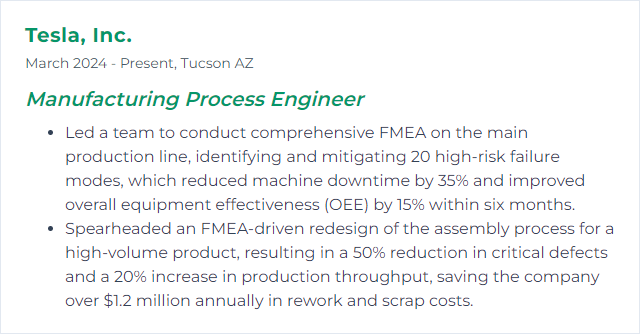
12. PLC Programming
PLC programming defines the logic that runs machines—ladder, structured text, function blocks—to automate sequences, interlocks, and safety.
Why It's Important
It turns processes into predictable, repeatable operations. Faster startups, safer cells, better OEE.
How to Improve PLC Programming Skills
Build reliable control with less downtime:
Master Fundamentals: Addressing, scan cycles, task prioritization, and the main IEC 61131-3 languages.
Solve Real Problems: Work through commissioning issues, changeovers, and fault handling—hands-on wins.
Know Your Hardware: Rockwell, Siemens, or others—module specs, comms, and diagnostics matter.
Learn from Peers: Participate in practitioner communities and code reviews to share patterns and pitfalls.
Keep Learning: Courses and vendor docs to track new firmware, safety PLCs, and motion control.
Best Practices: Modular code, clear tags and comments, version control, and safe states on fault.
Simulate First: Use digital twins or PLC simulators to test logic before touching the line.
The result is cleaner code, quicker troubleshooting, and fewer 2 a.m. calls.
How to Display PLC Programming Skills on Your Resume
